Note: If an image ever fails to appear - refresh your page, it really is there
Flags and standards of the German Emperor (1871-1918)written and edited by "Fornax" and Pete Loeser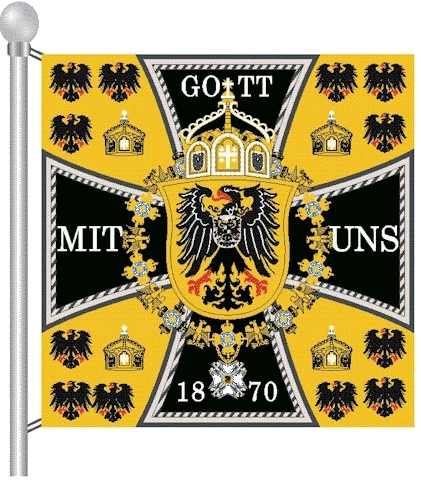
When on January 18, 1871, the German Empire was proclaimed inside the Versailles palace in France, only few people thought about symbols for the new "Second Empire." One of them was Friedrich, the son of Wilhelm I, who became the first German Emperor. He asked the heraldist Graf Harrach to design a new coat-of-arms on the day before the Empire was proclaimed
The second interested in a new standard was the supreme heraldist of Prussia, Graf Stillfried, who had already been thinking about a standard for a German Emperor. In January of 1871 he created a model that consisted of a yellow (gold) square with an Iron Cross. Laid on the cross was the Prussian eagle with the Arms of "Hohenzollern" on his breast. On top of the silver colored shield there was a "South German" crown. Each of the corners of the standard was equipped with three Prussian eagles. Wilhelm I, however, was not very interested in the flag design and postponed the matter.
|
|
|
Proposed Emperor´s Standard
by Graf Stillfried (January 1871) |
|
King of Prussia´s Standard
1871-1918 |
Only on August 3, 1871, Wilhelm presented his own version of a standard that was influenced by his son, Friedrich, who insisted on using a standard with a red (royal purple) colored cloth. Red (royal purple) was used as the field of the standard for the Prussian King, a position that was held by Wilhelm as well. Friedrich wanted to continue this using this color as the color for the German Emperor. This made the first standard of the German Emperor looked very much like the standard for the Prussian king with its red background.
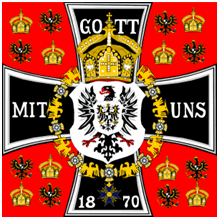
First Emperor´s Standard
August 3, 1871 - October 15, 1871 Laid on the Iron Cross, which contained the motto "Gott mit uns" (God with us), was the Prussian eagle on a white (silver) shield, topped by the new Emperors crown. The shield was surrounded by the "Kette des Schwarzen Adler Ordens" (chain of the black eagle order). Each of the four corners of the standard was equipped with two Prussian eagles and two Emperor´s crowns.
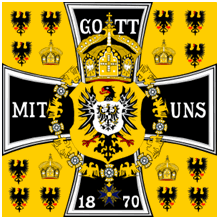
Second Emperor´s Standard
October 15, 1871 -
December 6, 1888 Soon there arose protest against this design. The now supreme heraldist of the Empire, Graf Stillfried, was not at all satisfied with the adopted standard. He was of the opinion that gold (yellow) and not red (royal purple) was the color of an Emperor, because this was the most precious color of all. Wilhelm agreed to that statement and ordered to change the color of the flag cloth from red (royal purple) to yellow (gold). On October 15, 1871, a new design was presented. Apart from the changed color of the cloth, the shield was now yellow (gold) too. Moreover, the corners were henceforth equipped with three Reichsadler (Reich eagles) without a breast shield and only one Emperor´s crown.
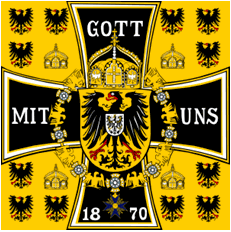
Third Emperor´s Standard
December 6, 1888 - November 1918
In 1888, the son of Friedrich III, Wilhelm II became the new German Emperor. He was very interested in the design of flags and decided on December 6, 1888, to "modernize" the design of the Emperor´s standard. The Reich eagle was reshaped and so was the Emperor´s crown. This third and final design was used until the end of World War I in 1918, when the German Empire ceased to exist.

Mysterious Emperor´s Standard
Imperial War Museum, London Somewhat obscure is a variant of the third model that is exhibited in the Imperial War Museum in London. This variant shows the small corner eagles with an added breast shield. Down to the present day nobody can say if this variant was ever officially in use or what was its function, respectively.
The Emperor´s standard was used for all purposes when the Emperor was present. For example, it could be put on a building, fixed on the fender of a car, and, of course, it was hoisted on the top mast of a ship as long as "His Majesty" was on board. The latter case entailed a rather intricate sequence of rules of protocol. Thirty-three shots were demanded for salute. While passing by the ship carrying the Emperor a crew had to call three times "Hurrah," the Emperor's hymn "Heil Dir dem Siegerkranz" had to be played, and a lot more was required until the ship with the Emperor was about 200 meters away from the passed by ship.
Because the Emperor felt these procedures were, in some cases, too elaborate, in 1895, he introduced a special Breitwimpel (broad pennant). After this, at the Emperor's pleasure, the Breitwimpel could be hoisted in place of his standard to temporarily "waive" the rules of protocol. The Breitwimpel of the Emperor replaced the Emperor´s standard and was considered the highest command flag of the Imperial Navy.

The "Breitwimpel" (broad pennant) 1895-1918 The Breitwimpel had the shape of a pennant. Towards the left side there was an Iron Cross on which was applied the Emperor´s crown, which was underlain with a sword and a sceptre, respectively.
In the year 1900, the Imperial navy adopted the rank of a Grand Admiral, in order to have an equivalent to the rank of Field Marshal in the army. Wilhelm II was the first person to hold this rank. The command flag for a Grand Admiral consisted of a white square with the Iron Cross applied with Marshal´s batons and the Emperor´s crown to which two crown ribbons were added.
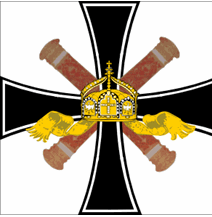
Grand Admiral of the Imperial Navy
Used by the Emperor - May 3, 1900-1918 Sometimes the Emperor´s standard and the Grand Admiral´s command flag were hoisted on board a ship at the same time, but "His Majesty" either was not on board at the moment, or did not intend to receive any visitors. For these occasions, the Emperor, in 1905, introduced two special "Wappenflaggen" (Arms flags) which were hoisted half way up of the top mast. The first, indicating that he was "not on board" consisted of a yellow square surrounded by a red and white border. In the center of the flag there was a black heraldic lion. The second, indicating that he "was on board," but did not wish to receive any visitors, consisted of a blue square containing a yellow sceptre.
|
|
|
"His Majesty is not on board"
Wappenflagge -
October 17, 1905-1918 |
|
"His Majesty is not receiving visitors"
Wappenflagge -
October 17, 1905-1918 |
The last time the Emperor's Standard was officially used was on November 10, 1918, when Wilhelm II went into his exile in the Netherlands. Driving in a car, equipped with the standard on the fender, Wilhelm II was asked to surrender it to a border guard when he left Germany for the last time. In 1998, this standard was sold in an auction for about 13.000 Euros.
| Top of Page | Return to "Flags of the Second Reich" | Return to "World War I Flags: Central Powers" |
| Return to "Historical Flags of Germany" | Return to "Vexillological Essays and Chart Pages Menu" |
|